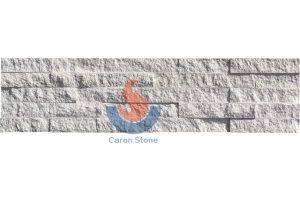In our lives, there is a seemingly ordinary but very charming stone – limestone. Though it is not as hard as granite or as brilliant as marble, its distinctive look and broad use subtly influences our planet. From prehistoric pyramids to contemporary architectural accents, limestone is all around. What therefore are the enigmatic veils concealed in this simple stone? Let us unveil the mystery of limestone, explore its origin, properties and uses, and discover this seemingly plain but surprising natural miracle.

White Limestone Splitted Culture stone
Formation and composition of limestone
limestone’s formation is similar to a natural history drama. Comprising mostly calcite (CaCO₃) or aragonite (CaCO₃·H₂O), it is a sedimentary rock. Usually, limestone production depends on the calcium carbonate deposition in seawater in a warm, shallow marine habitat. From the remains of marine life including algae, shells, and coral, these calcium carbonates can originate. These organic relics gather underwater over time and finally turn into hard limestone by compaction.
Limestone’s Diverse Properties
Texture and Colour
Limestone’s color and texture are like a natural canvas. It can be a gentle gray, a warm cream, or perhaps dark brown. On its surface, limestone often has a distinctive texture; it may be smooth as a mirror at times and occasionally shows natural veins and blotches. Every piece of limestone has different beauty and uniqueness because to these natural colors and textures.
Physical Properties
Interesting are also the texture and hardness of limestone. Compared to marble and granite, limestone is less hard, which makes it easier to work with, but also means that it is less wear-resistant. But limestone’s softness makes carving and cutting simple, and many ancient buildings and sculptures made from limestone.
chemical characteristics
Limestone’s chemical properties are also unique. Mostly consisting of calcium carbonate, it reacts readily when it comes into contact with acidic compounds generating carbon dioxide gas. This quality finds application not only in building but also in some labs to assess alkalinity and acidity. Actually, limestone is utilized to balance water and soil acidity; this “chemical magic” is really crucial in water treatment and agriculture.
Application fields of limestone
Architecture and decoration
Limestone has a long history of application in architecture and decoration. From the Pantheon in ancient Rome to the walls of the City of David and the ancient Egyptian pyramids, limestone is used in all these historic structures. Modern structures also frequently feature limestone for walls, flooring, facades, and other locations. The structure seems more natural and pleasant from its natural color and texture.
Sculpture Art
Limestone is also an indispensable “canvas” in sculpture art. With sensitive tools, sculptors can create beautiful sculptures on its surface as it is somewhat soft. From ancient temple carvings to modern art installations, limestone provides artists with unlimited creative possibilities.
Environmental protection
The role of limestone in environmental protection cannot be ignored. It is frequently used to change soil pH and raise soil fertility; limestone can assist neutralize water acidity and eliminate contaminants in water treatment. In addition, limestone is also used to treat industrial waste gas, reduce sulfur dioxide emissions in the air, and protect air quality.
Industrial Uses
In industrial production, limestone finds extensive application in fertilizer manufacture, steel smelting, and cement production. High temperatures are utilized to break down calcium oxide, a main raw ingredient used in cement manufacture, from limestone. Limestone is used in steel manufacture to purify iron ore and eliminate contaminants from it.
Protection and Maintenance for Limestone
Although limestone has a wide range of uses, it also requires proper protection and maintenance. Limestone should be avoided coming into touch with acidic cleaners or chemicals since it is sensitive to such compounds. In addition, regular cleaning and polishing are also essential to maintain the beauty and durability of limestone. Appropriate limestone conservation helps to maintain its appealing qualities in several uses.

White Limestone Splitted Culture Stone
Limestone, this seemingly ordinary stone, actually contains rich natural mysteries and practical value. From its unusual production process to its varied physical and chemical characteristics to its extensive use, limestone is a vital and varied part of our life. It is not only a traditional material for construction and sculpture, but also an important component in environmental protection and industrial production. Knowing the features and uses of limestone will enable us to maximize this natural resource and provide more beauty and convenience to our life. Let’s see limestone’s natural beauty and utility from a more appreciative standpoint.





